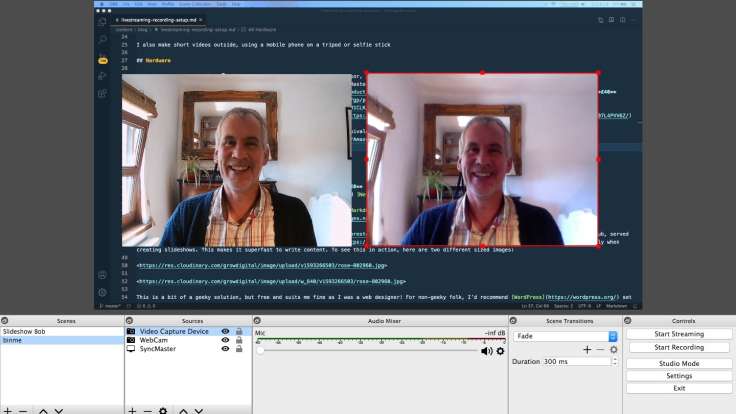
OBS Studio livestreaming software, showing difference in quality between external & built-in webcams
Here’s my current setup of computers & equipment for livestreaming, recording and editing videos for my online forest garden courses. Hopefully this will help if you want to set up your own 😎
With the onset of the Covid-19 lockdown in the UK, I decided to concentrate on remote, online forest garden courses and workshops. To that end, I’ve created a rudimentary but effective setup. I’ll give all the geeky technical details to make it easier to compare equipment.
Workflow
My workflow is pretty simple. I make a slideshow, and then record the slideshow on one screen (screencast) and record myself with the webcam. This is recorded and/or livestreamed. I then edit the video and upload it.
I also make short videos outside, using a mobile phone on a tripod or selfie stick.
Hardware
- Laptop: 9 year old 😲 MacBook Air, 1.7GHz Intel i5 processor, 2GB RAM, 250GB hard disk £400 equivalent
- 2nd monitor: invaluable for recording & editing; Samsung SyncMaster P2450, 1920x1080 resolution £80 equivalent
- Webcam: Fusion5 Full HD Webcam the only one I could get! Much better than built-in webcam. £40
- Microphone: Marantz Pro MPM1000U USB, made a huge difference. £50
- Mic stand: InnoGear very handy for getting mic out of the way quickly! £15
- Mobile: used for outdoor livestreaming & video, Honor10Lite £140
- Lavalier mic: for outdoor recording, plug into phone £20 equivalent
- Tripod: AmazonBasics 60" lightweight £25
- Lighting: 3 bright lamps, light from the side and the back!
- Backdrop: Length of patterned tablecloth with bamboo £8.99
Websites
- Website: Hugo, with custom built theme £0
- Hosting: GitHub and Netlify £0
- Image hosting: Cloudinary
- Slideshow: Remark simple in-browser, Markdown-driven slideshow
- Aspect calculator: Aspect Ratio Calculator, always work in 16:9 aspect_ratio
I host the slideshows online (eg my course slideshows), using Remark files on GitHub, served to the Netlify web host. I also host all my images on Cloudinary, which means I can change the size of the images on-the-fly when creating slideshows. This makes it superfast to write content. To see this in action, here are two different sized images:
https://res.cloudinary.com/growdigital/image/upload/v1593266503/rose-802960.jpg
https://res.cloudinary.com/growdigital/image/upload/w_640/v1593266503/rose-802960.jpg
This is a bit of a geeky solution, but it’s free and suits me fine as I was a web designer! For non-geeky folk, I’d recommend WordPress set up by a decent web designer, and then expect to pay £20 per month web hosting. For slideshows, look at alternatives.
Media Software
- Recording & editing: Screenflow mac-only & expensive but records the webcam and the screencast separately, which is invaluable. Check out alternatives. $129
- Audio: Ocenaudio good workflow, simple interface £0
- Graphics: Inkscape for making title screens £0, Pixelmator (mac-only) for bitmap editing. £40
- Livestreaming: OBS Studio, like a mini-TV studio on your computer, amazing! Hooks up with Twitch for livestreaming from your computer. £0
Channels
- Livestreaming: Twitch, owned by Amazon, another purveyor of corporate surveillance. But, hey, it’s free. £0
- Video archive: YouTube, owned by Google, who are evil and engage in corporate surveillance. But, hey, it’s free. £0
- Chat: Chatty is a Java app that lets you use the Twitch chat without having to open a browser window. Speeds things up a bit 🙂
- Conference calls: Zoom 40 minute limit on group meetings. I use Zoom for Q&As and interactive workshops.
Course platform
- Teachable: just the platform (ie put courses together) without the marketing. Possibly worth it if you have a dedicated audience already, expect to pay about £40 per month.
- Udemy: platform and marketing. They do have to the ability to sell your courses at discounts. Advantage is, you have less marketing work to do.
I haven’t looked at the pricing too closely but I would imagine Udemy takes a bigger cut, whereas Teachable has a monthly fee.